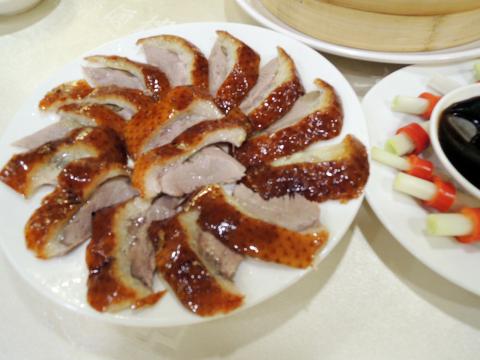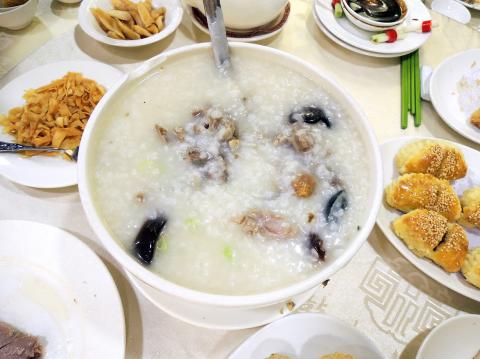Chinese roast duck is a famous dish, and dozens of restaurants in Taipei City offer this specialty. But excellent roast duck is hard to find due to the difficulty of cooking it. Among the kitchens specializing in the dish, Dragon Restaurant (龍都酒樓), or Long Du in Chinese, is a favorite of many serious diners.
Established in 1983, Long Du is a Cantonese restaurant about a 10-minute walk from the Zhongshan MRT Station (中山站). Its roast duck was voted No. 2 in Taiwan in a roast duck survey conducted by Taiwanese search engine Yam (蕃薯藤) last year. The restaurant is always busy, so I made a reservation about half a month ago. Within minutes of our arrival, my family and I were seated at our big round table on the first floor of the three-story restaurant. Although the seating was tight, the high ceiling and chandeliers that hung above added a nice touch to the room.
We ordered four appetizers for NT$50 each: kelp, burdock, century eggs, and dried radishes. In 15 minutes, the waitress served our pre-ordered Cantonese Roast Duck (廣式片皮鴨, NT$1,200) — along with the garnishes: thin pancakes, green onions and sweet bean sauce.

Photo: Eddy Chang, Taipei Times
Eating at Long Du is as much about watching a performance as it is about eating good food. Our waitress first showed us the whole duck, including the head, and asked how we would like it to be cut. Unlike Peking duck, which is cooked with less seasoning and consists mostly of crispy skin and little meat, there are two ways to do it at Long Du: cut the meat with or without the skin. Our duck was large enough for us to enjoy it both ways. She then skillfully sliced the duck into small pieces and arranged them on two plates beautifully next to our table. I felt like I was watching an exciting cooking show.
For the first plate, the crispy skin, duck fat, and juicy meat were a perfect combination. But for the second, the meat was slightly dry since the fat was trimmed. How to eat Chinese roast duck properly? Always remember to fold the bottom of your duck pancake, because the sauce may drip on your lap if you fail to do it right.
Apart from its signature duck, Long Du is famous for its popular Cantonese Duck Congee (薑絲皮蛋鴨骨粥, NT$300), which is a must try. Our congee was cooked with the duck meat and bones left over from the carved bird, century eggs, and shredded ginger. The robust duck flavor penetrated the perfectly boiled creamy rice.

Photo: Eddy Chang, Taipei Times
One cannot go to a Cantonese restaurant without ordering some dim sum. Long Du offers over 30 varieties of dim sum priced between NT$78 and NT$128. We ordered Sesame Balls (流沙芝麻球, NT$78), Radish Cakes (臘味蘿蔔糕, NT$78), Spare Ribs (豉汁蒸排骨, NT$90), Spring Rolls (上海炸春捲, NT$90), Barbecue Pork Pastries (蜜汁叉燒酥, NT$100) and Radish Pastries (蘿蔔絲酥餅, NT$100). I enjoyed the moist filling of the radish pastries and strongly recommend the dish. But some of the dishes are only available at lunch, including radish pastries. If you prefer dim sum, it’s better to go for lunch.
For the big meal for seven adults, I paid NT$3,390 (NT$485 per person), including a 10-percent service charge. The restaurant offers a NT$100 coupon for every NT$1,000 spent, so I received three NT$100 coupons for my next visit. Overall, Long Du was a pleasant dining experience. It is a good choice for all duck lovers and whoever likes to try one of the signature dishes of Chinese cuisine.
And a reminder to those who go: The number of ducks per day is limited. Be sure to make a reservation two to three weeks in advance.

Photo: Eddy Chang, Taipei Times

Photo: Eddy Chang, Taipei Times

Most heroes are remembered for the battles they fought. Taiwan’s Black Bat Squadron is remembered for flying into Chinese airspace 838 times between 1953 and 1967, and for the 148 men whose sacrifice bought the intelligence that kept Taiwan secure. Two-thirds of the squadron died carrying out missions most people wouldn’t learn about for another 40 years. The squadron lost 15 aircraft and 148 crew members over those 14 years, making it the deadliest unit in Taiwan’s military history by casualty rate. They flew at night, often at low altitudes, straight into some of the most heavily defended airspace in Asia.

Taiwan’s democracy is at risk. Be very alarmed. This is not a drill. The current constitutional crisis progressed slowly, then suddenly. Political tensions, partisan hostility and emotions are all running high right when cool heads and calm negotiation are most needed. Oxford defines brinkmanship as: “The art or practice of pursuing a dangerous policy to the limits of safety before stopping, especially in politics.” It says the term comes from a quote from a 1956 Cold War interview with then-American Secretary of State John Foster Dulles, when he said: ‘The ability to get to the verge without getting into the war is

Like much in the world today, theater has experienced major disruptions over the six years since COVID-19. The pandemic, the war in Ukraine and social media have created a new normal of geopolitical and information uncertainty, and the performing arts are not immune to these effects. “Ten years ago people wanted to come to the theater to engage with important issues, but now the Internet allows them to engage with those issues powerfully and immediately,” said Faith Tan, programming director of the Esplanade in Singapore, speaking last week in Japan. “One reaction to unpredictability has been a renewed emphasis on

Beijing’s ironic, abusive tantrums aimed at Japan since Japanese Prime Minister Sanae Takaichi publicly stated that a Taiwan contingency would be an existential crisis for Japan, have revealed for all the world to see that the People’s Republic of China (PRC) lusts after Okinawa. We all owe Takaichi a debt of thanks for getting the PRC to make that public. The PRC and its netizens, taking their cue from the Chinese Communist Party (CCP), are presenting Okinawa by mirroring the claims about Taiwan. Official PRC propaganda organs began to wax lyrical about Okinawa’s “unsettled status” beginning last month. A Global